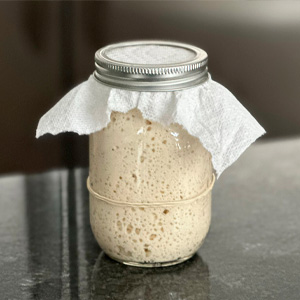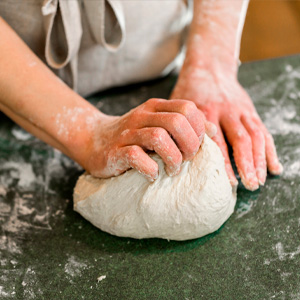
Let’s dive into how you can make your own sourdough bread, starting with handy baking tools you can find at Goodwill NCW and a special ingredient called a “starter”.
Making sourdough bread is like going on an exciting adventure. It’s fun, a bit challenging and super rewarding when you take that first bite of your own tangy, crispy bread. Plus, when you use tools found at your local Goodwill NCW, you’re not just baking; you’re also helping the planet and supporting employment services for neighbors in your community.
Tools You’ll Need
Before we start mixing and baking, we need some tools. You can find many of these tools at Goodwill NCW.
Here’s what to look for:
Large mixing bowls: Big bowls made of ceramic or glass are perfect for mixing your dough.
Cast iron Dutch oven or bread pan: Baking your bread in an oven-safe Dutch oven makes the crust super crispy and delicious. If using a bread pan, make sure to cover it with tin foil loosely while it bakes.

Scales: Baking is like a science experiment, and using a scale to measure your ingredients makes everything more accurate. For sourdough, you’ll want to measure all ingredients in grams.
Dough scrapers: These help you get the sticky dough off your counter without making a huge mess.
Bannetons or any medium-sized bowl: These baskets or bowls will hold your dough while it ferments.
Linen cloths: These cloths are great for covering your dough while it rises or for wrapping your starter. Plus, they’re reusable!
Knives: Look for a sharp knife for scoring your dough and a serrated bread knife for slicing your loaf after baking.

Let’s Bake!
Starting with the starter:
The first step in our sourdough adventure is making sure you have an active starter. This is a mix of flour and water that sits out for a few days, catching wild yeast from the air. This wild yeast makes the bread rise and gives it a yummy tangy flavor. If you’ve read our previous blog, you already know how to get your starter bubbling and ready.
Ingredients:
Bread Flour: 400 grams
Salt: 8 grams
Filtered Water: 300 grams, separated (290 grams, 10 grams)
Active Starter: 80 grams
With your tools ready, it’s time to bake:
Mixing: First, mix flour, 290 grams of water and your starter in a big bowl. This starts the dough-making process. Cover the bowl with a towel and let sit for one hour. Then you will add 8 grams of salt and 10 grams of water and mix with your hands.
Stretching: Stretch dough from the outside edges to the middle of the bowl. Set timer for 30 minutes and repeat one time. Set timer for 30 minutes before folding.
Folding: Fold the dough by lifting it from the bottom of the bowl and letting it fold under itself. Set a timer for 30 minutes and repeat one time.
Proofing: Put your dough back in the bowl, cover it with a cloth, and let it sit. This is when the dough rises and becomes flavorful. This will usually take between 6-10 hours depending on the temperature of your home. A home at 70 degrees will take about 8 hours. A cooler home will take a little longer and a warmer home will take less time. When you can poke your dough and it is no longer sticky and has doubled in size, it is ready to be shaped. Over-proofing your dough will result in flat bread that will not rise in the oven. You can use over-proofed dough to make focaccia bread.
Shaping: Shape the dough and put it in a floured basket/bowl to keep its shape. Cover the bowl with a damp cloth and place it in the refrigerator for 12 hours to 5 days. The longer the dough ferments in the refrigerator, the tangier or sourer the dough will become.
Baking: Preheat oven to 475 degrees with your Dutch oven inside. When the oven is preheated, remove the hot Dutch oven, line with parchment paper, score the dough, put the dough inside, place three ice cubes anywhere in the Dutch oven along the dough, replace the lid and bake for 50 minutes. Remove the lid to brown the bread to your liking.

We recommend baking for about 5-10 minutes more. The hot Dutch oven and steam from the ice cubes make the crust just right. If you use a bread pan, there is no need to preheat the pan, just make sure to cover it loosely with tin foil, leaving room for the dough to rise for 50 minutes, then remove the tinfoil for the last 10 minutes.
Enjoy Your Bread!
Voilà! You’ve got your very own sourdough bread. It smells amazing, and waiting for it to cool down might be the hardest part.
This whole process isn’t just about making bread. By choosing tools from Goodwill NCW, you are part of a bigger picture of protecting our planet and giving back to the community. Every purchase diverts items from the landfill and supports training for people to build job skills that lead to sustained employment and improved financial stability.
Thanks for making sourdough with Goodwill NCW!
